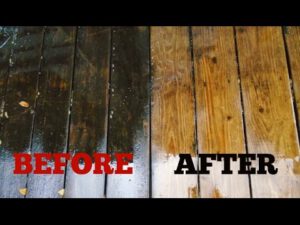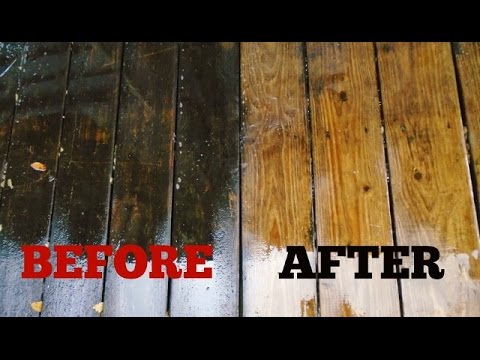When it comes to cleaning wood for staining, it’s a good idea to start with a fresh, clean surface. Sweep away loose debris with a broom, then spray the deck surface with a cleaner and allow it to soak for the recommended time frame.
This cleaner is an EPA Safer Choice and is less toxic than bleach-based products. It also repels dirt and stains, so the deck doesn’t need as much maintenance. However, if you need some professional help, you can contact Pro Deck Builders Charleston.
The first step is to remove any debris that has accumulated on the deck surface. This can include leaves, pine needles, and dirt. A simple broom or leaf blower can help clear the surface, while a putty knife can be used to get in between the boards and any nooks and crannies where debris can collect.
A garden hose with a spray nozzle will be useful to evenly disperse the cleaning solution on the surface. The spray also helps to loosen any dirt and grime that has collected on the wood.
Next, a deck cleaner that is formulated for the type of decking, whether wood or composite, should be applied. Some are available in pre-mixed formulas, while others must be diluted with water. If you are using a dilution, make sure to follow the manufacturer’s instructions to avoid damaging the surface.
Some deck cleaners contain mildewcide, which prevents the growth of future mold and mildew. If you are treating a specific problem area, a stronger scrub brush may be needed to remove the mildew stains.
Vinegar, whether diluted or not, is a common household cleaning agent that works well on many surfaces. However, if it is allowed to soak into the deck or is left on too long, it will cause the wood to leach, which can damage and weaken the structure.
If you want to use a natural cleaning product, try a mix of baking soda and vinegar or distilled white vinegar. Vinegar is a strong deodorizer and can even be effective in removing ants. Baking soda, on the other hand, is a gentler alternative that can be used to clean many different surfaces and is especially good for scrubbing greasy or sticky areas.
Pre-Rinse
A deck needs more than a broom and a dustpan to look its best. Summer hot dogs, fall leaves, harsh winter weather, and general wear and tear take a toll on natural wood or composite decking. It’s time for a deep clean before you put your deck back to use.
Before you apply a cleaning solution, spritz the deck with water to soften the dried cellulose fibers that hold dirt and mildew. This pre-rinse will also allow the cleaner to be dispersed more easily. A superfine sprayer attachment on a garden hose works well.
Start by applying a wood brightener that’s formulated for your deck’s type of wood. Many of these products include a detergent, bleach, and a chemical that reacts with the specific woods to remove stains and brighten the deck’s appearance. Read the product’s label and follow the manufacturer’s directions for application.
A few squirts of a deck cleaner will help with dirt and mildew removal, but you may need a stronger product to get rid of particularly stubborn problems. Bleach—especially chlorine bleach—will whiten the deck unnaturally, corrode metal elements, and harm plant life. Look for a non-chlorine bleach that contains oxygen, which will kill mold and algae and remove stains.
After you’ve scrubbed and rinsed, let the deck dry thoroughly. Ideally, you want to wait 48 hours before you walk on it and until it’s dry enough to feel without a splinter between your feet.
While you wait, check for loose screws or nails in the ledger board, rails, and joists. Tighten or replace as necessary. Also look for areas where the deck boards are separating at the seams. If you have a lot of these areas, it’s likely the deck is sagging and will need to be sanded or replaced.
Scrub
Before you apply any cleaner, rinse your deck with a garden hose to get rid of any dirt and debris stuck to it. This helps the cleaner disperse and work more effectively. It also protects plants that are close by from the harsh chemicals in some cleaning products.
Chlorine bleach-containing cleaners are not recommended for cleaning treated wood, such as that used on a deck, because they can damage it and leave it with an unnatural whitewashed look. They may also raise the grain of the wood, causing it to become rougher and more likely to attract mildew. Chlorine bleach-containing cleaners can also corrode metal fasteners and screws, which may cause them to loosen or even rust. Additionally, it can discolor wood and break down in sunlight, which can cause the surface to fade over time.
A safer alternative to chlorine bleach is oxygen bleach. This product is available as a liquid or as a powder, and it works well to remove oil and grease stains as well as mildew stains. This cleaner is gentle enough to use on stained decks and will not harm nearby landscaping or pets if you are careful. For tough stains, you can add powdered borax to the oxygen bleach solution and scrub thoroughly before rinsing.
Always follow the instructions on the label of the cleaner you choose. Work in sections, and make sure to allow the cleaning solution to set for the amount of time suggested by the manufacturer. Once the time is up, use a hard-bristled broom with synthetic bristles to scrub the area. If needed, sand the area with a sander to help smooth it out.
Apply the cleaner.
The best cleaners remove a wide range of grime, from dirt and mildew to fungus. Some are biodegradable, which helps protect the environment from toxins seeping into lawns and other plant areas. Others are formulated to leave behind a protective coating that discourages future mildew and mold growth.
A sprayer or mop works best for applying the cleaner. For tough spots, you can also use a scrub brush. Regardless of the method, wear rubber gloves to protect your skin and eyes from splashes. Some cleaners contain bleach or oxidizing agents that can cause irritation, so always follow the manufacturer’s instructions for wearing eye protection and gloves.
If your deck has dark stains that don’t fade even after cleaning, consider buying a product designed to lighten wood and brighten fading stains. Also known as restorative cleaners, these products typically feature oxygenated ingredients such as sodium percarbonate that work like bleach but are safer for wood than oxalic acid. Some of these cleaners are also designed to be used before staining to help the new coat of stain take on a more uniform color, which is important for making sure that your deck looks good and lasts long after it’s stained.
Another option is a pre-mixed solution, such as the one from Simple Green Oxy Solve Total. This ready-to-use cleaner doesn’t need to be mixed or diluted, which makes it more convenient than some other options. This cleaner is certified as a U.S. EPA Safer Choice cleaner, which means that it’s safe to use around people, plants, pets, wildlife, and waterways, unlike some other options. It’s also very effective at removing a variety of contaminants, including black algae, mold, and mildew.
Let it dry.
As soon as the deck is clean, it must be allowed to dry thoroughly. This will ensure that the new stain is properly absorbed and won’t be flaked off by moisture, as can happen if you apply a water-based stain to a damp deck. A light sweeping (daily, ideally) will quickly remove twigs, dirt, and other natural debris from the surface, but if your deck is especially large or heavily stained, you may want to consider investing in a cordless blower that makes quick work of twigs and other debris and allows you to reach high areas without a ladder. A few brands of these are available that do a good job and are safe for use on wood surfaces.
After the deck is fully dry, you can replace any softly rotting boards and stain the deck. Staining isn’t a simple process, but it isn’t difficult either. Before you begin, make sure that the weather is good and that you have the time to dedicate to the project. It is best to avoid staining on a windy day. One gust could send splatters of your stain all over windows, siding, and nearby plants. Cover any shrubbery with tarps or plastic drop cloths to prevent damage from overspray.
There are many different wood cleaners available to purchase or make at home, but a few are essential to the staining process. A TSP substitute will quickly remove most stains and is safe for use on all types of wood. Oxalic acid wood cleaner can also remove tannin stains and iron stains, which are common on redwood and cedar decks. However, it is not as effective against mildew or other organic stains. Be sure to read and follow all product directions carefully, and always wear rubber gloves when mixing or applying the cleaners, as many contain ingredients that can irritate skin.
